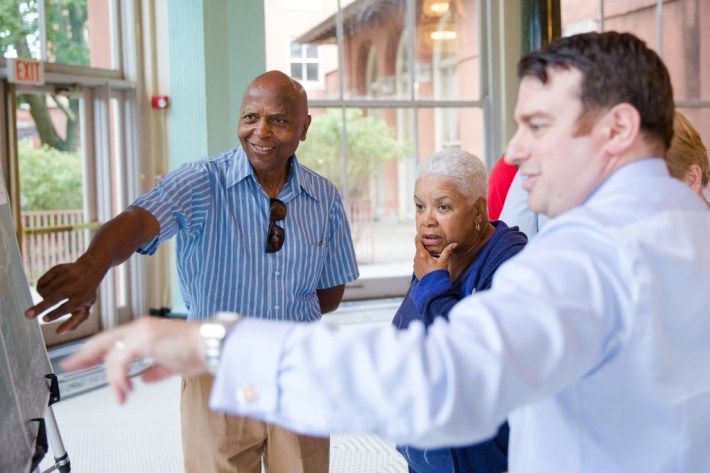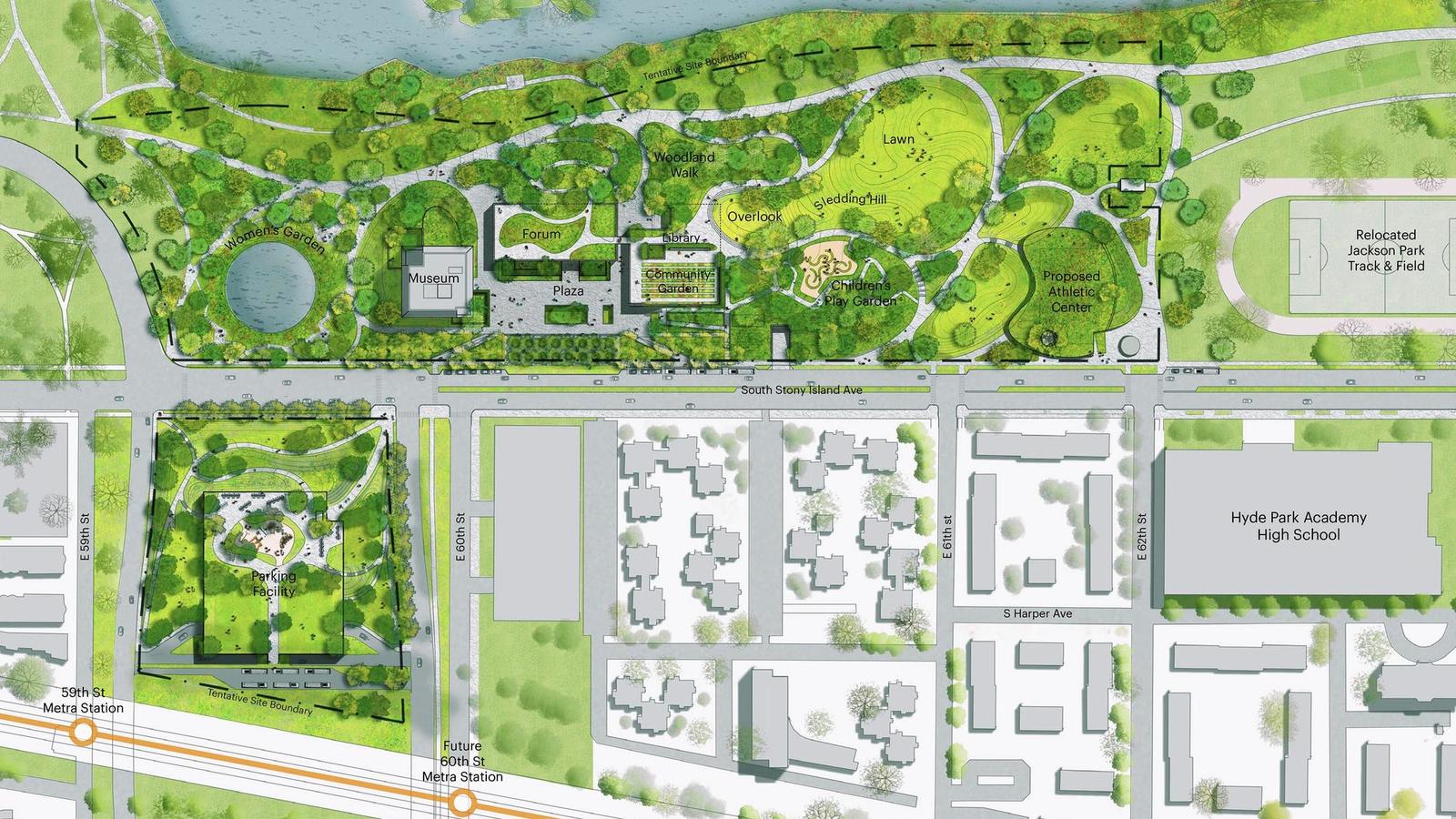At public meetings on Wednesday and Thursday, officials from the Chicago Department of Transportation and the Obama Foundation revealed the latest site plans for the Obama Presidential Center ("the library"), which included details about how the foundation plans to build an aboveground parking garage on parkland.
CDOT commissioner Rebekah Scheinfeld described how her department intends to widen and add a lane to Lake Shore Drive between 57th Street to Hayes Drive (7/8 of a mile), and widen and add two lanes Stony Island Avenue between 59th Street to 63rd Street (half a mile).
Neither of those parts of the library project are the roads we should be going down.
In addition to the parkland being given away for the library, when a better site next to the Garfield Green Line station was also available without giving away parkland, the library project would include a two-story structure for 400-450 cars on the Midway Plaisance lawn between the Metra Electric tracks and Stony Island.
Instead of being able to debate, "What's the best use of this piece of the Midway Plaisance?" city officials have already given away that agency and authority.
The lawn, which could be used for lots of things – and people tell me it's used by youth sports teams – will cease to be parkland, and even though it will have a use, will generate not property taxes but car traffic.
Mayor Emanuel and the foundation insist the the parking garage will be disguised by landscaping and there will be a park on the roof.
Parks generally belong on the ground. When Amtrak's development partner for Union Station revealed plans for a "raised plaza", Tribune design critic Blair Kamin said "In real life, elevated public spaces often struggle to draw crowds because they're raised above the flow of pedestrian traffic."
Mayor Emanuel said, "And by doing a green roof I think it goes a long way toward meeting other needs." Except, it's a park now, doing the job of a green roof by absorbing water that runs off the street.

Those new lanes will cost CDOT several millions of dollars. The exact amount hasn't been publicized yet. The parking garage will cost the Obama Foundation tens of millions more dollars. That could subsidize a low-cost transit fare for millions of visitors. Or pay for new and better transit in the area, even though this section of Hyde Park is already well-served compared to dozens of neighborhoods in Chicago.
What I think is worse about the parking garage idea, however, is that city and foundation officials are talking about how to continue to accommodate our culture of driving everywhere and storing cars in public and subsidized spaces. No one is talking about the climate change impacts of this, nor the resiliency of continuing to build expensive infrastructure for what we know is a destructive mode of transportation.
For instance, CDOT's slideshow indicates that their proposed road changes would increase car capacity to far above current use, adding space for 8,000 more vehicles each day than Stony Island, Cornell, and Lake Shore Drive currently carry (slide 20). And that's 15,000 more cars than they project will be driven on those roads in 2040. A city focused on expanding access to and service of multi-modal and sustainable transportation wouldn't be doing that.
Neither CDOT nor the Obama Foundation, nor President Barack Obama himself, when he announced that there would be a parking garage, is talking about how efficient and sustainable modes like bicycling and transit will be improved around the library.
How will people from other neighborhoods bike here? How will people staying at downtown hotels be encouraged to take the very fast Metra Electric, or one of the express buses? How will those buses get to move even faster, for library visitors and residents who aren't visiting the library? How will our buses be slowed down by the addition of 400-450 cars each day?
No one will be encouraged to take transit from downtown as long as parking is adjacent and driving is uninterrupted – because of widening the roads – and parking is subsidized.
Mayor Emanuel said, "We are in the beginning of the process as a city," but as a couple of residents have shared with me personally, and others have pointed out, the library planning is happening too fast, without a quality public input process, and with many issues already decided.
How do we know the parking garage is necessary? How many visitors is the Obama center supposed to get each day? How many of them are going to come from Chicago, and how many are going to stay in nearby hotels and short-term home rentals? Where are non-parkland spaces available on which to build parking structures? Is there no space in existing parking structures?
Further promulgating the lack of sustainable transportation design in proposals we've seen so far is the widening of Stony Island. The Tribune reported that "foundation officials said [the parking garage] would increase pedestrian traffic to areas around the presidential center." If that's true, then it doesn't make any sense to put those pedestrians in harm's way by widening roads and filling them with more cars.
Existing car parking on Stony Island would remain in the current proposal, despite the addition of the parking garage. If the parking was removed, Stony Island could get extra lanes without being widened.
The intersection at Stony Island and 59th would also be enlarged, and the latest site plan shows a removed crosswalk, and a widened curve so motorists can turn right faster, without having to slow down for those pesky library visitors.
All of this comes down to the fact that we're planning for the car-dependent future the Obama library and CDOT officials want to have, which differs from what CDOT says at meetings on other sides of town when they propose "neighborhood greenways" that make for quieter and safer streets, or when the Chicago Transit Authority tried to propose better bus service on Ashland Avenue.
With Jackson Park's car-friendly future now enshrined, children will continue to be subjected to air pollution, residents will continued to be bothered by noise and vibrations, and everyone will still be subjected to the dangers of car crashes on a daily basis.
None of these proposed transportation changes, except for the closure of Cornell Drive in favor of a serene park-like setting for the library, enhance the neighborhood. The changes ensure that drivers passing through are not delayed, and protects the American right to get to a highway as quickly as possible. They are all reactions to a planning paradigm that continues delaying a real adoption of environmentally-friendly, climate-change embracing solution.
The solution doesn't only require sustainability: Transit and bicycling are also the most cost effective transportation modes, and give families an option that doesn't require a costly membership in car culture.
Mayor Emanuel said the City of Chicago will abide the Paris Climate Agreement, even if the president won't, but building car infrastructure over transit infrastructure isn't how you support that agreement.





